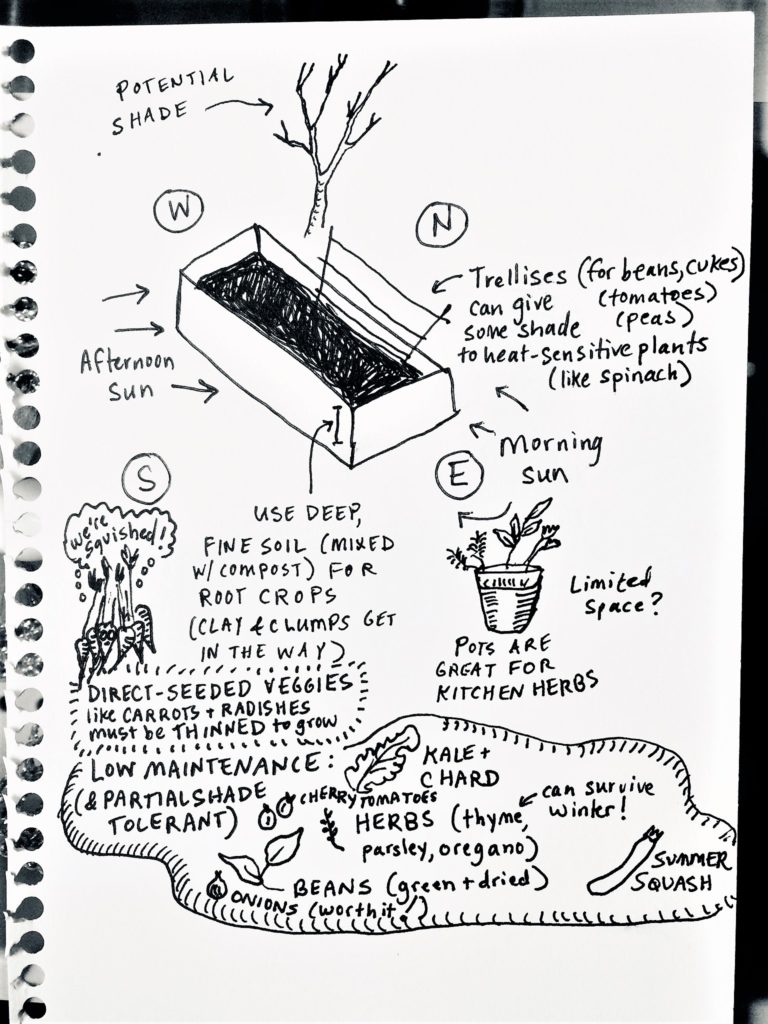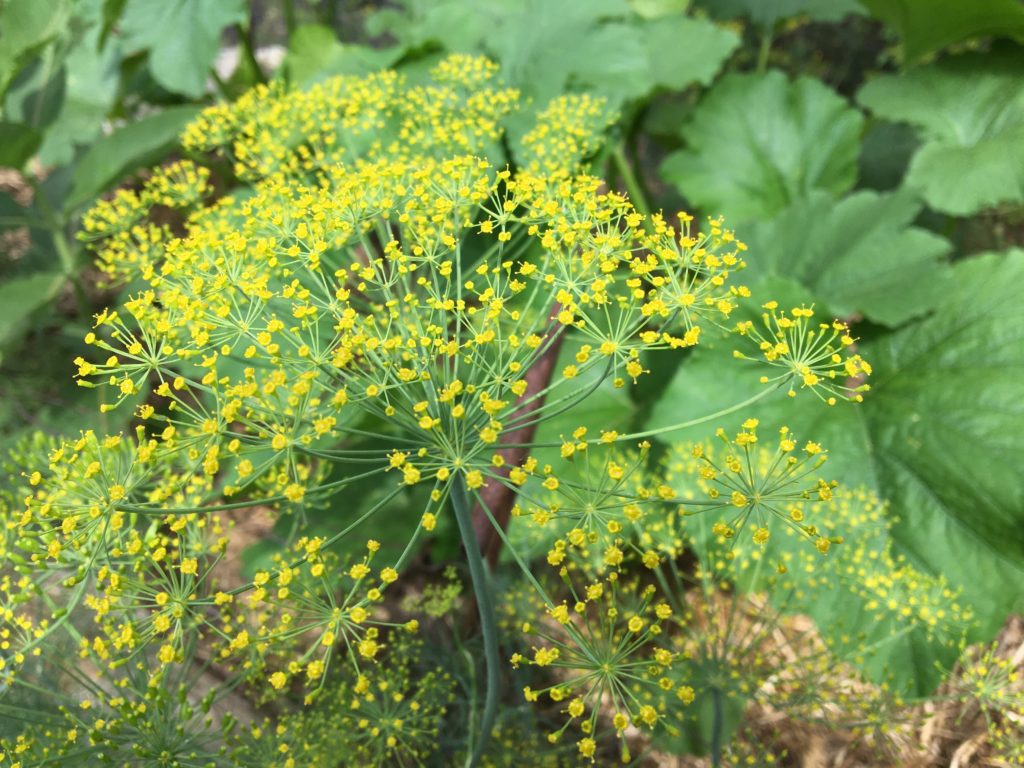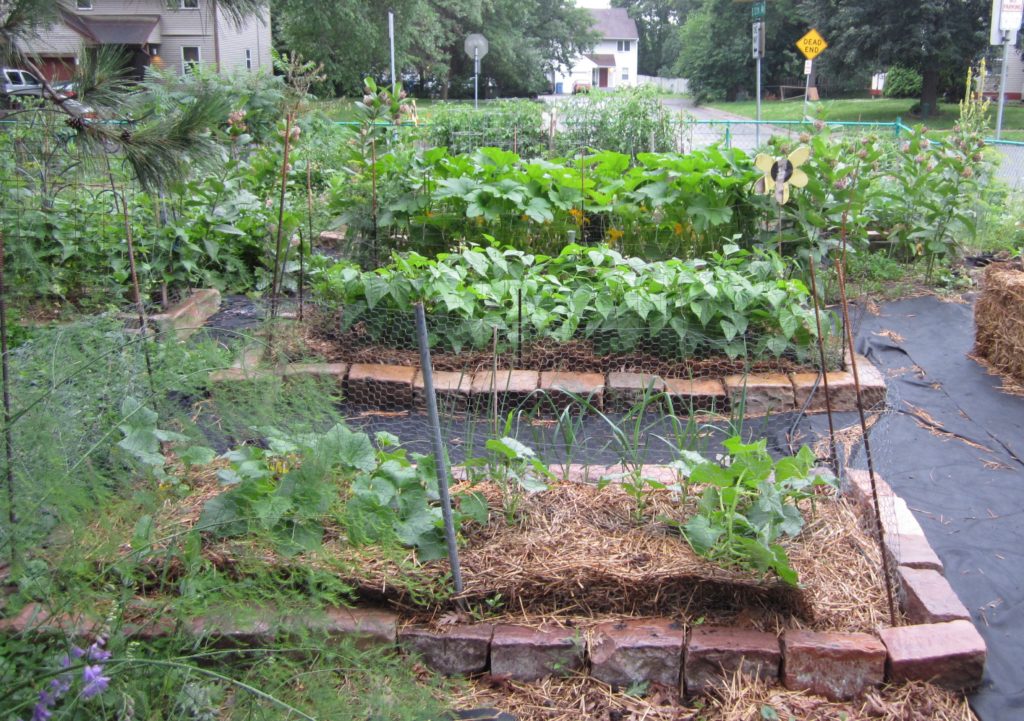By MARY ELLEN KALUZA
(illustrations by Jessie Merriam, photos by Mary Ellen Kaluza of her garden)
March in Minnesota. The days are noticeably longer. We are longing to have dirt under our nails. But isn’t it too early? There’s still snow on the ground. It’s the perfect time to get the garden started.
First: Plan your garden
Know your space””how much sun do you get in the different areas? Put your parka on and go outside. Imagine the trees are fully leafed-out and the sun moving high across the sky. Most vegetables need a lot of sun. Leafy greens can do well in more shaded areas and may actually produce larger leaves valiantly trying to absorb as much sunlight as possible. Save the sunniest areas for tomatoes, peppers, and other fruiting plants. Carrots and other root vegetables will tolerate some shade.
Make your wish list, then pare it down to fit your space. Map out your garden with sun and plant size in mind. Buy your seeds!

Second: Start your seeds
Starting plants from seed is a great way to save money. Seeds will stay viable for a few years and store easily in a glass jar in the fridge. You can get dozens of plants out of a $2 – $3 packet.
A lot of vegetables can be seeded directly into the soil. Read the seed packets for planting times and instructions. In short growing seasons, like Minnesota, many plants must be started inside a month or two before they can go outside.
Save clear plastic clamshell packaging from lettuce or berries to start your seeds.You can control the moisture and warmth with the lid. Save other plastic tubs ”“ yogurt, sour cream, anything you can punch drain holes into for transplanting the little starts into later on.
Set up your own seed-starting nursery when the timing is right (read the packets). I recommend spending a little money on seed-starting potting mix. I”™ve tried regular outdoor dirt and general potting soils and had my heart broken.
You”™ll need more light than what comes through the windows. I bought a used 4 foot fluorescent light fixture that I hang a couple inches above the seed pots in the basement. Seeds need warmth to germinate so I drape aluminum foil over the light and plants (which I reuse each year). Adjust the lights as the plants grow. Sixteen hours of light a day is a good rule of thumb.
Thin the little starts to allow room to grow. That”™s where the larger containers you saved come in””transplant the babies after they have “true” leaves and can safely be handled into regular potting soil. When the days are warm enough, gradually move the plants outdoors. Give them an hour or two in a protected area outside to start, increasing the time and exposure to sun and wind over a week or two until they are out all night (keeping an eye on the forecast for danger of frost.) The soil will dry faster outdoors, so be mindful of watering.
Third: Direct seed and transplant
Your cool weather plants can be directly seeded when the soil is dry enough to work in early April. Think kale, lettuce, peas, radishes…
After the danger of frost has passed (mid to late May), transplant your babies into their permanent locations. Plant your seeds for beans, cucumbers and other warm weather plants directly into the soil.
Fourth: Feed, mulch, enjoy
Give your plants a nutritious boost to grow bigger and more beautiful. There are plenty of ways to feed your plants, organic or not. Mulch garden beds to keep down weeds and hold in moisture.
When your neighbors tell you how wonderful your garden looks you can proudly say you grew it all from seed!
Author Mary Ellen Kaluza is a Certified Financial Counselor with LSS Financial Counseling. A version of this blog first appeared in Sense & Centsibility blog page.
LSS Financial Counseling offers free counseling for budgeting, debt, student loans, foreclosure prevention, credit report reviews, and much more.
Phone: 888-577-2227 Website: www.lssfinancialcounseling.org

















